I want to calculate the number of times two individuals share the same group number. I'm working with quite a large dataset (169 individuals and over a 1000 observations (rows) of them) and I'm looking for an efficient way to count the occurrence of them being in the same group. My (simplified) data looks like this:
| ID | Group number | Date | Time |
|---|---|---|---|
| Aa | 1 | 15-06-22 | 15:05:22 |
| Bd | 1 | 15-06-22 | 15:05:27 |
| Cr | 2 | 15-06-22 | 15:07:12 |
| Bd | 1 | 15-06-22 | 17:33:15 |
| Aa | 2 | 15-06-22 | 17:36:54 |
| Cr | 2 | 15-06-22 | 17:37:01 |
| ... |
I would like my output data to look like this:
| Aa-Bd | Aa-Cr | Bd-Cr | ... |
|---|---|---|---|
| 1 | 1 | 0 |
Or:
| Occurrence | Dyad |
|---|---|
| 1 | Aa-Bd; Aa-Cr |
| 0 | Bd-Cr |
Or even a matrix might work. I've been trying to replicate the solution posed for this problem: Count occurrences of a variable having two given values corresponding to one value of another variable but for some reason my matrix remains empty, even though I know that certain individuals have been in groups with others.
Any help and suggestions would be extremely appreciated! I feel like the solution shouldn't be too complicated but for some reason I can't seem to figure it out.
Thanks in advance!
Edit: some example data from dput():
dput(c[1:5,])
structure(list(Date = structure(c(19129, 19129, 19129, 19129,
19129), class = "Date"), Time = c("11:05:58", "11:06:06", "11:06:16",
"11:06:33", "11:06:59"), Data = structure(c(1L, 1L, 1L, 1L, 1L
), .Label = "Crossing", class = "factor"), Group = structure(c(5L,
5L, 5L, 5L, 5L), .Label = c("Ankhase", "Baie Dankie", "Kubu",
"Lemon Tree", "Noha"), class = "factor"), IDIndividual1 = structure(c(158L,
158L, 34L, 153L, 14L), .Label = c("Aaa", "Aal", "Aan", "Aapi",
"Aar", "Aara", "Aare", "Aat", "Amst", "App", "Asis", "Awa", "Beir",
"Bela", "Bet", "Buk", "Daa", "Dais", "Dazz", "Deli", "Dewe",
"Dian", "Digb", "Dix", "Dok", "Dore", "Eina", "Eis", "Enge",
"Fle", "Flu", "Fur", "Gale", "Gaya", "Gese", "Gha", "Ghid", "Gib",
"Gil", "Ginq", "Gobe", "Godu", "Goe", "Gom", "Gran", "Gree",
"Gri", "Gris", "Griv", "Guat", "Gub", "Guba", "Gubh", "Guz",
"Haai", "Hee", "Heer", "Heli", "Hond", "Kom", "Lail", "Lewe",
"Lif", "Lill", "Lizz", "Mara", "Mas", "Miel", "Misk", "Moes",
"Mom", "Mui", "Naal", "Nak", "Ncok", "Nda", "Ndaw", "Ndl", "Ndon",
"Ndum", "Nge", "Nko", "Nkos", "Non", "Nooi", "Numb", "Nurk",
"Nuu", "Obse", "Oerw", "Oke", "Ome", "Oort", "Ouli", "Oup", "Palm",
"Pann", "Papp", "Pie", "Piep", "Pix", "Pom", "Popp", "Prai",
"Prat", "Pret", "Prim", "Puol", "Raba", "Rafa", "Ram", "Rat",
"Rede", "Ree", "Reen", "Regi", "Ren", "Reno", "Rid", "Rim", "Rioj",
"Riss", "Riva", "Rivi", "Roc", "Sari", "Sey", "Sho", "Sig", "Sirk",
"Sitr", "Skem", "Sla", "Spe", "Summary", "Syl", "Tam", "Ted",
"Tev", "Udup", "Uls", "Umb", "Unk", "UnkAM", "UnkBB", "UnkJ",
"UnkJF", "UnkJM", "Upps", "Utic", "Utr", "Vla", "Vul", "Xala",
"Xar", "Xeni", "Xia", "Xian", "Xih", "Xin", "Xinp", "Xop", "Yam",
"Yamu", "Yara", "Yaz", "Yelo", "Yodo", "Yuko"), class = "factor"),
Behaviour = structure(c(2L, 3L, 1L, 1L, 1L), .Label = c("Crossing",
"First Approacher", "First Crosser", "Last Crosser", "Summary"
), class = "factor"), CrossingType = c("Road - Ground Level",
"Road - Ground Level", "Road - Ground Level", "Road - Ground Level",
"Road - Ground Level"), GPSS = c(-27.9999, -27.9999, -27.9999,
-27.9999, -27.9999), GPSE = c(31.20376, 31.20376, 31.20376,
31.20376, 31.20376), Context = structure(c(1L, 1L, 1L, 1L,
1L), .Label = c("Crossing", "Feeding", "Moving", "Unknown"
), class = "factor"), Observers = structure(c(12L, 12L, 12L,
12L, 12L), .Label = c("Christelle", "Christelle; Giulia",
"Christelle; Maria", "Elif; Giulia", "Josefien; Zach; Flavia; Maria",
"Mathieu", "Mathieu; Giulia", "Mike; Mila", "Mila", "Mila; Christelle; Giulia",
"Mila; Elif", "Mila; Giulia", "Nokubonga; Mila", "Nokubonga; Tam; Flavia",
"Nokubonga; Tam; Flavia; Maria", "Nokubonga; Zach; Flavia; Maria",
"Tam; Flavia", "Tam; Zach; Flavia; Maria", "Zach", "Zach; Elif; Giulia",
"Zach; Flavia; Maria", "Zach; Giulia"), class = "factor"),
DeviceId = structure(c(10L, 10L, 10L, 10L, 10L), .Label = c("{129F4050-2294-0D43-890F-3B2DEF58FC1A}",
"{1A678F44-DB8C-1245-8DD7-9C2F92F086CA}", "{1B249FD2-AA95-5745-9A32-56CDD0587018}",
"{2C7026A6-6EDC-BA4F-84EC-3DDADFFD4FD7}", "{2E489E9F-00BE-E342-8CAE-941618B2F0E6}",
"{359CEB57-351F-F54F-B2BD-77A05FB6C349}", "{3727647C-B73A-184B-B187-D6BF75646B84}",
"{7A4E6639-7387-7648-88EC-7FD27A0F258A}", "{854B02F2-5979-174A-AAE8-398C21664824}",
"{89B5C791-1F71-0149-A2F7-F05E0197F501}", "{D92DF19A-9021-A740-AD99-DCCE1D88E064}"
), class = "factor"), Obs.nr = c(1, 1, 1, 1, 1), Gp.nr = c(1,
3, 3, 4, 5)), row.names = c(NA, -5L), groups = structure(list(
Obs.nr = 1, .rows = structure(list(1:5), ptype = integer(0), class = c("vctrs_list_of",
"vctrs_vctr", "list"))), row.names = c(NA, -1L), class = c("tbl_df",
"tbl", "data.frame"), .drop = TRUE), class = c("grouped_df",
"tbl_df", "tbl", "data.frame"))
In here Gp.nr is my group number, IDIndividual1 is my ID.

